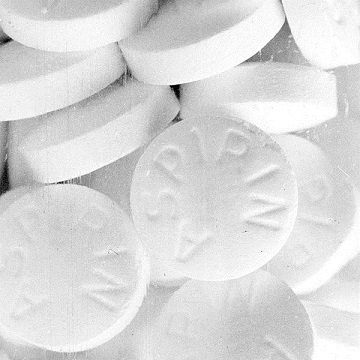
From the Wikimedia Commons.
A new study published in JAMA sheds further light on a controversial question – whether or not to prescribe low-dose aspirin (81-100mg) for the primary prevention of vascular disease (strokes and heart attacks).
Primary prevention means preventing a negative medical outcome prior to the onset of disease, in this case preventing the first heart attack or stroke. Secondary prevention refers to treatments given to patients who have already had their first heart attack or stroke in order to reduce the risk of subsequent events.
The evidence strongly supports the efficacy of aspirin for the secondary prevention of both heart attacks and strokes. Aspirin has two effects which likely contribute to this protective effect. First, aspirin is an anti-platelet agent – it reduces the stickiness of platelets, which are cell fragments in the blood that clump together to stop bleeding. They can also clump together around an ulcerated cholesterol plaque on an artery, forming a thrombus, resulting in blockage or embolus (the clot traveling downstream) and causing either a heart attack or stroke.
Other anti-platelet agents, such as clopidogrel, are also effective in preventing stroke and heart attack.
Of course, platelets exist for a reason, and blocking their action increases the risk of bleeding or can make bleeding worse when it occurs. Therefore determining the optimal dose and target population are important to maximize the benefit of aspirin or other anti-platelet agent while minimizing the bleeding risk.
A second mechanism of aspirin which likely contributes to its protective effect is that it is an anti-inflammatory. Inflammation likely contributes to atherosclerotic disease. This anti-inflammatory effect may also provide protection for diseases other than vascular disease. For example, there is some evidence that aspirin may also be useful in the prevention of certain types of cancer. However, as with primary prevention, any potential benefit is small compared to the burden of the disease, and has to be carefully weighed against side effects.
So, while it is the standard of care to prescribe daily aspirin or an equally effective drug to patients who have had a vascular event, it remains somewhat controversial whether aspirin should be given for primary prevention, and if so, in which populations.
A 2009 systematic review of aspirin for primary prevention concluded:
Aspirin reduces the risk for myocardial infarction in men and strokes in women. Aspirin use increases the risk for serious bleeding events.
We have found that there is a fine balance between benefits and risks from regular aspirin use in primary prevention of CVD.
That about sums up the situation – a fine balance. This means that we are trying to find slight advantages by studying very large populations and following them for many years. Perhaps, in the right patient population (those with a certain risk), we might eke out a small outcome advantage. In the US we tend to prescribe aspirin for primary prevention in high-risk populations, those with high cholesterol, hypertension, and diabetes, for example.
On this background comes the new study from Japan. They followed 14,464 patients for up to 6 years, but with a mean follow up of 5 years. Half received aspirin and half received no aspirin. This was an open-label trial with no placebo. Study outcomes were adjudicated by a blinded multidisciplinary expert panel.
The study, which was for primary prevention but in high-risk patients, found that the incidence of non-fatal heart attacks were reduced by about 50% in the aspirin group and non-fatal strokes by about 40% in the aspirin group. However, fatal events were not reduced. Further, when all cardiovascular outcomes were combined, there was no statistically significant difference between the groups.
These results, in my opinion, keep the waters just as muddied as they were previously. Proponents of aspirin use in high-risk patients can point to the reduction in heart attacks and stroke, while critics can point to the lack of overall decrease in events, and to the lack of effect on survival.
It is also reasonable to ask if this Japanese population can be generalized to other populations. While the Japanese diet and therefore risks have been increasingly Westernized over recent decades, they continue to have lower overall risk than in the West (heart disease mortality rate is 1/3 to 1/5 that in the US). Lower risk means lower benefit from prevention.
Conclusion
While this recent study failed to show an overall benefit from low dose aspirin for the prevention of vascular events, it did show a benefit for the reduction in non-fatal heart attacks and strokes. Further, it is not clear if the study population can be applied to Western populations, especially since there is such a fine line between risk and benefit with this treatment.
In terms of the stakes of this question, you can look at it in one of two ways. From the individual perspective, the balance between risk and benefit for aspirin for primary prevention is slight. Aspirin will have a small statistical effect on overall health risk and may not have any net effect on survival.
From a population-based perspective, however, given the total burden of heart attacks and strokes, even a small statistical decrease in risk may translate into a large number of prevented events.
With this new study I think we are left in the same situation as before. Aspirin (or other anti-platelet or blood thinning treatment, as appropriate) should be used for secondary prevention of vascular disease – heart attacks and stroke. It should be considered for primary prevention in patients who are at risk for vascular disease, but an individualized decision should be made based on various factors. We cannot make, however, a blanket recommendation for aspirin for primary prevention.
